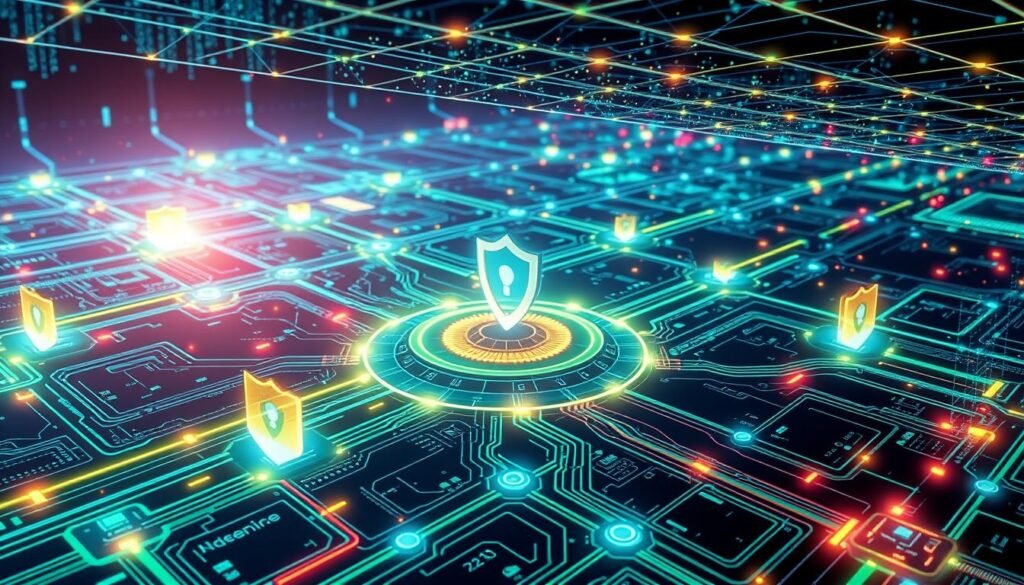The Internet of Things (IoT) has changed how we live and work. Edge AI is leading this change. It brings AI to the edge of the network, changing many industries.
Edge AI lets IoT devices process data on their own. This means less need for cloud connections. It also makes data safer and faster, and saves money by using less network bandwidth.
Edge AI changes how we use IoT devices. It lets them make decisions quickly. This is good for things like self-driving cars and smart factories.
Key Takeaways
- Edge AI enables real-time data processing and decision-making directly on IoT devices, eliminating the need for constant cloud connectivity.
- By bringing AI capabilities to the edge, Edge AI reduces latency, optimizes network bandwidth, and enhances security and privacy compared to traditional cloud-based AI systems.
- Edge AI is transforming a wide range of industries, from smart manufacturing and autonomous vehicles to healthcare and smart cities, by empowering IoT devices with intelligent, localized processing.
- The global Edge AI market is expected to grow rapidly in the coming years, driven by the increasing demand for low-latency, high-performance applications across various sectors.
- Edge AI offers significant benefits in terms of cost-effectiveness, power efficiency, and the ability to support autonomous systems and IoT networks.
Understanding Edge AI: Fundamentals and Core Concepts
Edge AI is a fast-growing field that works differently than traditional AI. It processes data right on the devices, not on cloud servers. This makes decisions quicker and reduces delays, which is great for things like self-driving cars and factory automation.
What Makes Edge AI Different from Traditional AI
The main difference is how it uses computing. Traditional AI sends data to cloud servers, which can slow things down. Edge AI, however, does its work on intelligent edge devices themselves. This means it can handle data and make decisions fast, perfect for situations where speed is crucial.
Key Components of Edge AI Architecture
An Edge AI system has a few key parts. First, there are edge devices that can run AI tasks. They also need sensors and internet to collect and process data. This setup lets AI work on its own, without needing the cloud as much.
The Evolution of AI Processing at the Edge
Edge AI has grown because people want AI that’s quicker and more responsive. With more devices connected to the internet, we need edge devices that can handle data fast. Edge AI helps by being more secure, using less power, and working well even when internet is bad.
“Edge AI is revolutionizing the way we interact with technology, enabling faster, more secure, and more efficient AI-powered applications across a wide range of industries.”
The Impact of Edge AI: How Localized AI Processing is Revolutionizing IoT Devices
Edge computing and distributed AI are changing how IoT devices work. Edge AI lets devices process AI algorithms on their own. This makes IoT devices better at analyzing data in real-time, reducing delays, and keeping data private.
Edge AI lets IoT devices make decisions on their own. They don’t need to be always connected to the cloud. This is great for places with no internet, as devices can still work well.
| Edge AI Capabilities | Advantages |
|---|---|
| Real-time data processing | Instant response times for critical applications |
| Localized decision-making | Improved efficiency and autonomy for IoT devices |
| Enhanced privacy and security | Reduced risk of data breaches and unauthorized access |
As edge computing and distributed AI grow, we’ll see new IoT uses in many fields. This includes smart cities, healthcare, and more. Edge AI makes IoT devices smarter, faster, and more reliable.

The future of IoT depends on edge AI. With over 30 billion IoT devices by 2025, edge AI’s role will grow. The global IoT market is set to hit $1.5 trillion by 2030, showing edge AI’s big impact.
Real-Time Processing and Decision Making in Edge AI Systems
The Edge AI market is growing fast, expected to hit $62.93 billion by 2030. Local AI processing is changing IoT devices in many fields. Edge AI is great for making quick decisions with real-time data.
Benefits of Instant Data Analysis
Edge AI lets devices analyze data right where it happens. This gives quick insights and cuts down on wait times. It’s super useful for fast decisions, like in self-driving cars, factories, and health checks.
By handling data locally, Edge AI avoids cloud delays. This makes operations quicker and more effective.
Low Latency Operations in Practice
The rise of 5G networks has boosted Edge AI. It speeds up data and cuts down on delays. This means Edge AI can make fast, accurate decisions.
For example, in self-driving cars, Edge AI quickly processes sensor data. This helps keep everyone safe and the car running smoothly.
Enhanced Response Times for Critical Applications
Edge AI is key for urgent, critical tasks. In healthcare, it watches vital signs and spots problems fast. This can save lives.
In emergencies, Edge AI uses data from cameras and sensors. It helps make quick, smart choices. This improves how we handle emergencies.
“Edge computing reduces reliance on network bandwidth, enhances operational efficiency, and enables rapid responses to changing conditions.”
Edge AI is perfect for fast, local insights and decisions. It’s great for IoT, self-driving cars, factories, and health care. By acting on data right away, Edge AI opens up new ways to innovate and improve.
Privacy and Security Advantages of Edge AI Implementation
The rise of Edge AI has changed how we handle data and privacy. It makes privacy-preserving analytics possible by keeping data close to the source. This reduces the chance of data breaches and helps follow data protection rules.
Edge AI is great because it lets devices process data on their own. This is especially useful in healthcare, where patient info stays private. It also gives better control over who can see and store data, making IoT systems safer.
Edge AI’s localized processing lets devices work together using their own data. This way, they can learn and improve without needing a central server. It’s a big step towards keeping user data safe.
“83% of research respondents believe that edge computing will be essential to remain competitive in the future.”
As more people want IoT solutions, Edge AI’s role in keeping data safe is key. It makes sure sensitive info is handled carefully, setting the stage for a future where privacy and security lead the way.

Edge AI has made IoT systems better by making them more efficient and secure. As it becomes more popular, we can expect a safer and more private digital world for everyone.
Edge AI Applications Across Different Industries
Edge AI is changing many industries with its ability to process data locally. It’s making big changes in fields like manufacturing, healthcare, and smart cities. This new way of using artificial intelligence is leading to big improvements in these areas.
Manufacturing and Industrial Automation
In manufacturing, edge AI helps with predictive maintenance and quality control. It looks at data from sensors and equipment in real-time. This way, it can spot problems before they happen, helping keep production going without stops.
Edge AI also makes sure products are consistent and reduces defects. This means better efficiency and lower costs for companies.
Healthcare and Medical Devices
The healthcare field is also seeing the benefits of edge AI. Devices like wearable monitors and smart medical tools are changing patient care. They provide real-time monitoring and quicker diagnosis.
Edge AI processes data locally, which means faster responses and less chance of data breaches. This is especially important in healthcare, where quick action can be a matter of life and death.
Smart Cities and Infrastructure
Edge AI is also making smart cities and infrastructure better. It helps manage traffic, energy use, and public safety. For example, AI-powered security cameras can respond faster than traditional systems, making cities safer.
Edge AI sensors and devices also help manage important infrastructure like water and waste. This leads to better use of resources and more efficient systems.
Edge AI’s wide range of uses shows its power and potential. As it keeps getting better, we’ll see even more ways it can change industries. It’s set to revolutionize how we do things in manufacturing, healthcare, and smart cities.

| Industry | Edge AI Application | Key Benefits |
|---|---|---|
| Manufacturing and Industrial Automation | Predictive maintenance, quality control, process optimization | Reduced downtime, improved product quality, increased efficiency |
| Healthcare and Medical Devices | Real-time patient monitoring, faster diagnostics | Improved patient outcomes, reduced response times, enhanced security |
| Smart Cities and Infrastructure | Traffic management, energy optimization, public safety | Efficient resource utilization, enhanced safety and security |
Cost Efficiency and Resource Optimization
The rise of energy-efficient AI and resource optimization has changed how we use cost-effective edge computing. Edge AI processes data locally, cutting down on cloud costs and bandwidth. This saves a lot of money and makes IoT devices last longer by using resources better.
In factories, edge AI helps control energy use, cutting down on costs. It analyzes data right where it’s made, not sending it to a central place. This saves on data transfer costs and boosts energy efficiency. It’s a smart choice for companies wanting to use resources wisely and get more value for their money.
| Benefit | Impact |
|---|---|
| Reduced Cloud Resource Dependency | Lower operating costs by processing data on-site instead of relying on costly cloud infrastructure |
| Optimized Energy Consumption | Decreased power requirements and extended device lifespan, leading to significant energy savings |
| Bandwidth Efficiency | Minimized data transmission, resulting in reduced bandwidth costs and improved network performance |
By using edge AI, companies can enter a new age of cost efficiency and resource optimization. This helps them innovate, make operations smoother, and stay ahead in the market.
“Edge AI is transforming the way organizations approach resource utilization, delivering tangible cost savings and operational efficiencies that are essential in today’s dynamic business landscape.”
Edge AI’s Role in Autonomous Systems and IoT Networks
Edge AI is key in changing how autonomous systems and IoT networks work. It lets devices make decisions on their own and behave smartly. This makes IoT networks work better, thanks to on-device learning and adapting.
Integration with IoT Ecosystems
Edge AI works well with IoT networks, making them run smoother and faster. It handles data locally, so devices don’t always need to connect to the cloud. This makes IoT devices work better and on their own.
It helps them make quick decisions and react fast, which is important for systems that need to act quickly.
Supporting Device Intelligence
Edge AI gives IoT devices a boost in smarts. They can learn and change on their own. This lets them make smart choices and get better over time, without needing the cloud all the time.
This makes IoT networks more independent and able to adapt better.
Network Performance Optimization
Edge AI is also great for making IoT networks run better. It balances tasks and cuts down on delays. This means devices use resources well and respond fast, even in big IoT setups.
This is key for things like self-driving cars, smart cities, and factory automation that need to act fast.
Edge AI is changing how autonomous systems and IoT networks work. It gives devices local smarts, boosts network performance, and makes systems more efficient and quick to respond. As more data is made at the edge, Edge AI is becoming essential for these advanced technologies.
Technical Challenges and Solutions in Edge AI Deployment
Edge computing and AI are changing how we handle data in many fields. But, they bring their own set of problems. Edge AI needs new ways to work around limited resources and special hardware.
One big issue is that edge devices can’t handle complex AI tasks well. They are small and use little power. To fix this, experts are making AI models smaller and more efficient. This lets them run on edge devices without trouble.
Another problem is that edge devices use a lot of power. They often run on batteries or have limited energy. New hardware and smart power management are helping to make edge AI more energy-friendly.
| Edge Computing Challenges | AI Deployment Solutions |
|---|---|
| Limited Computational Resources | Efficient AI Algorithms, Model Optimization |
| Power Constraints | Energy-Efficient Hardware, Dynamic Power Management |
| Specialized Hardware Requirements | Purpose-Built AI Processors, Federated Learning |
| Security and Privacy Concerns | Secure Edge Computing, Decentralized AI Processing |
Edge AI also needs special hardware to work well. General-purpose processors aren’t always the best. New AI processors like GPUs and TPUs are making edge AI faster and more efficient.
Integrating edge AI with existing systems and keeping data safe are also big tasks. Federated learning helps train AI models without sharing raw data. This is a step towards more secure edge AI.
Despite the hurdles, edge AI is changing many industries. It’s making healthcare, manufacturing, and more efficient and secure. With the right solutions, edge AI will keep pushing technology forward.
Conclusion
The future of IoT is closely linked with Edge AI. This technology is changing how we use our connected devices. As AI processors for edge devices improve, we’ll see new uses and a bigger role for artificial intelligence in our lives.
Edge AI is making a big difference in many fields, like healthcare and smart cities. It brings better privacy, faster responses, and smarter use of resources. It’s great for tasks that need quick decisions, like self-driving cars, industrial automation, and health monitoring.
Companies like Habana are leading the way in Edge AI. We can look forward to better AI processors, easier model use, and new tech like 5G. This mix of AI and IoT will make our devices more connected, responsive, and safe. They’ll meet our needs better and improve our lives.





